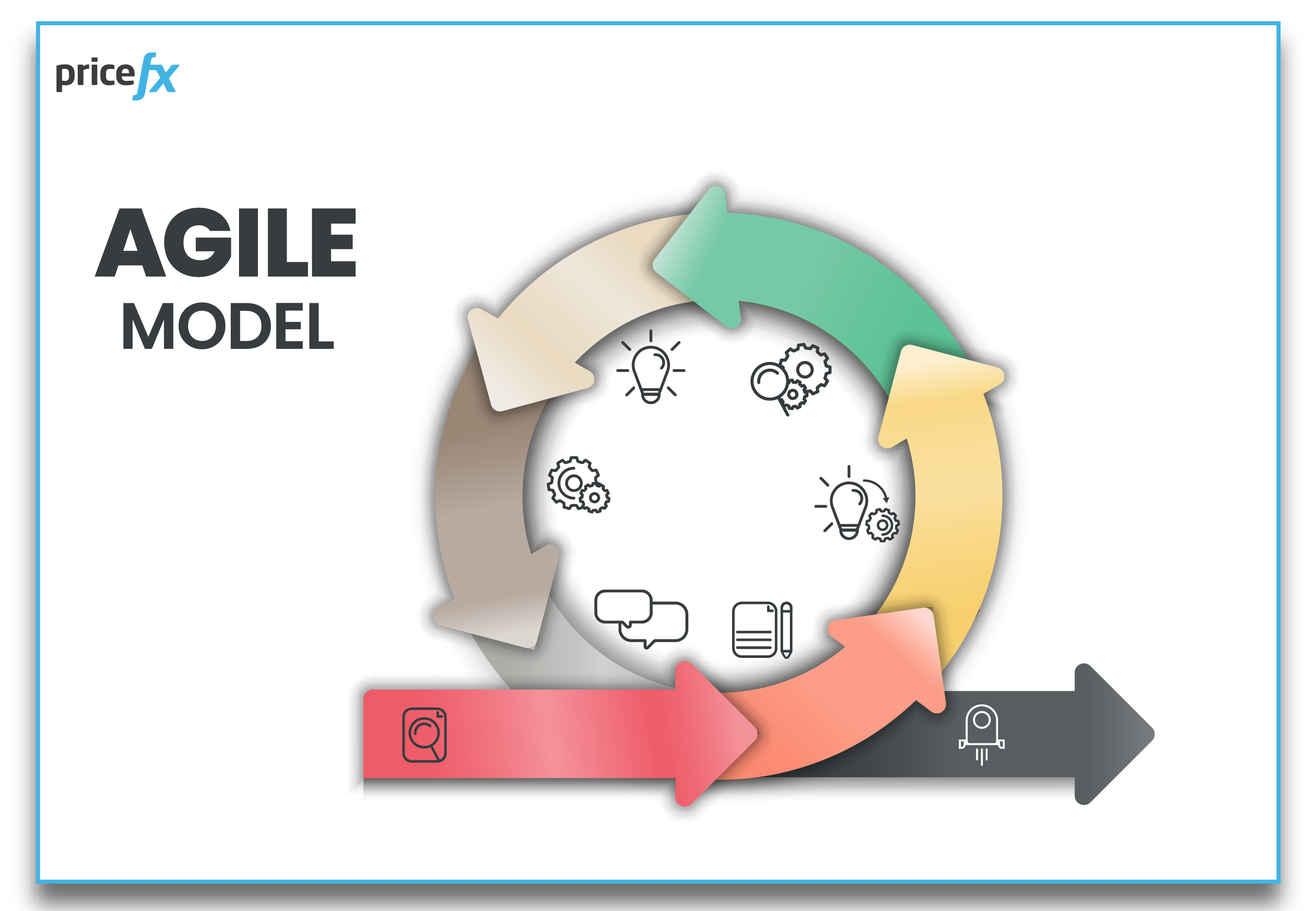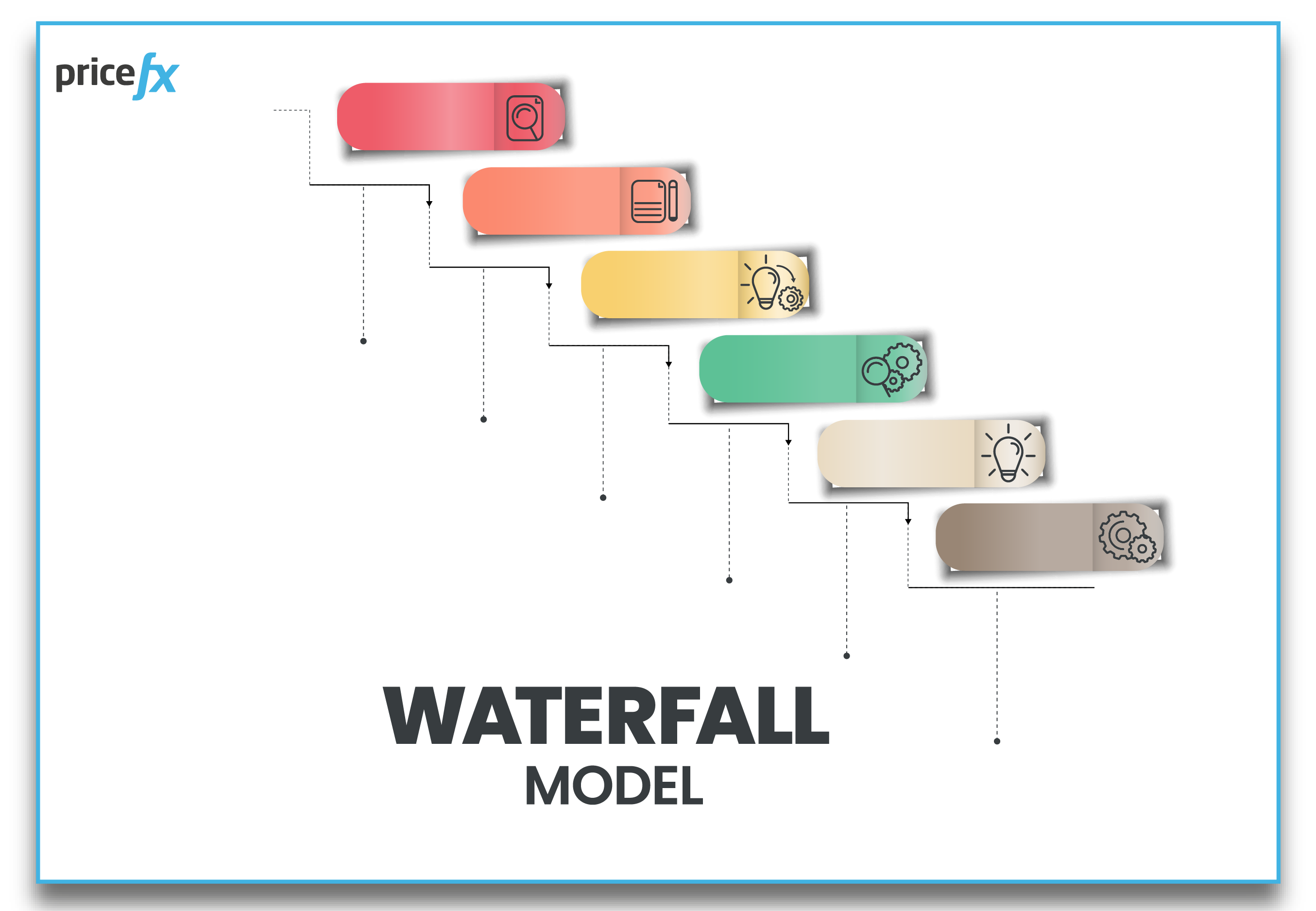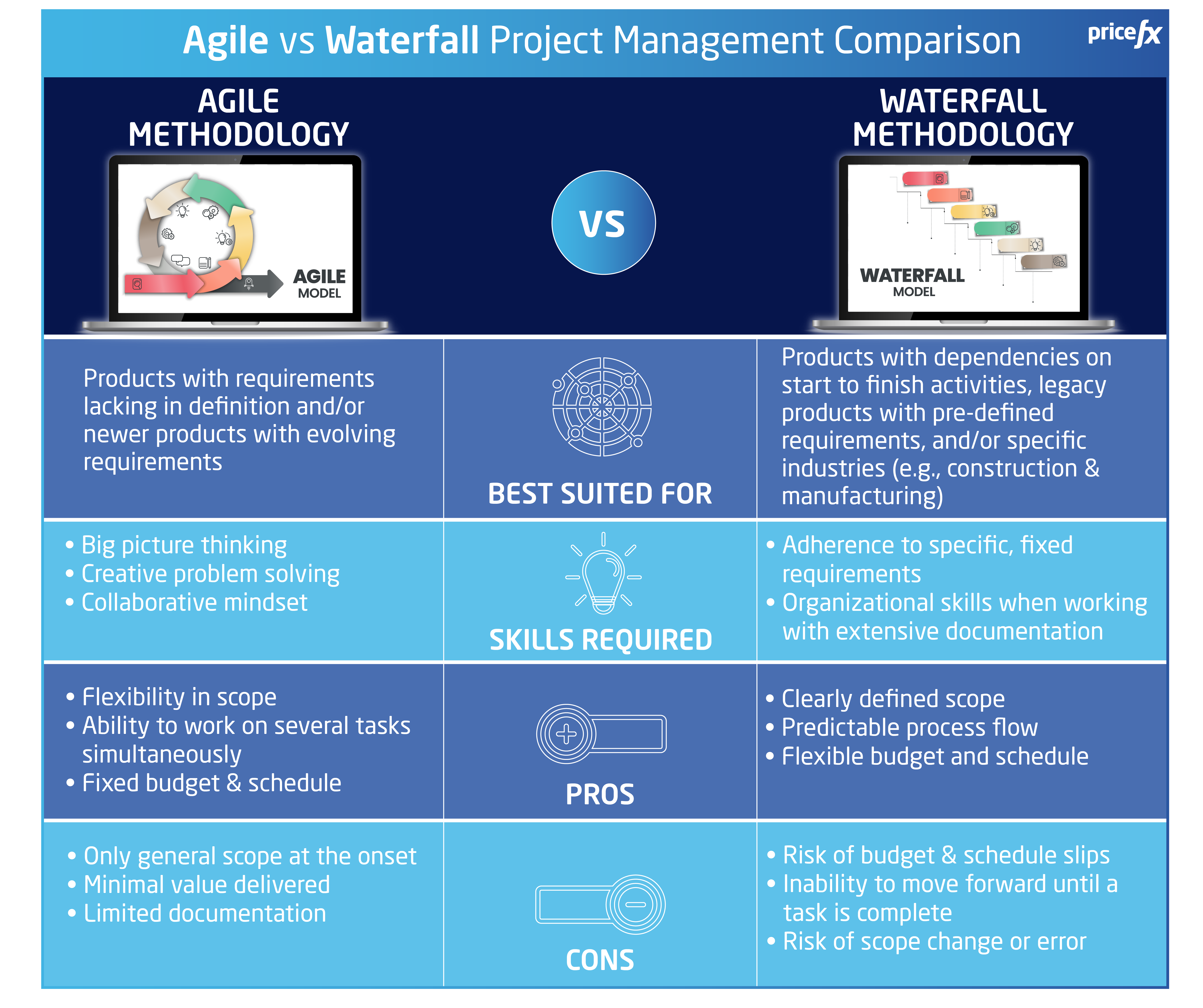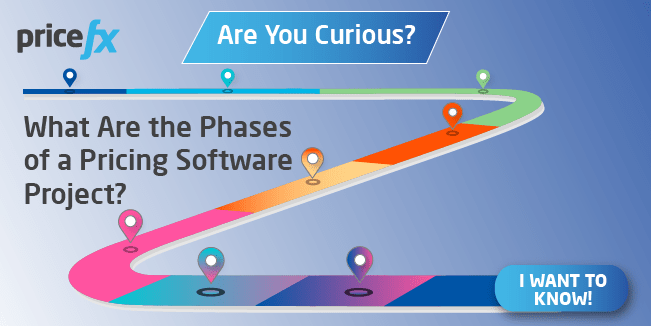Agile vs Waterfall Project Management: Benefits & Drawbacks
March 29th, 2023 (Updated 03/31/2023) | 8 min. read
You’ve probably come across references to Agile vs Waterfall project management at least once in your career, or at the very least in a throwaway comment in your LinkedIn feed. With “agile” becoming a popular buzzword in and of itself in the business world in recent years, it can be difficult to gauge what it all really means.
When your business doesn’t fully understand how each project management style serves them (or doesn’t), choosing the wrong one could cost them valuable time – and money – they can’t afford to lose.
Here at Pricefx, with over a decade of experience helping businesses roll out more efficient pricing processes with the help of our cloud-native pricing software, we recognize that software implementation can be a beast to manage – and for that reason, it’s crucial that its stakeholders employ the right project management strategy to get the job done well.
Waterfall and Agile are two historically well-known project management methodologies, but for different reasons. In a landscape where processes are constantly evolving to match the demands of the market, the Agile approach has eclipsed Waterfall project management, the strategy that historically dominated software development everywhere.
In this article, we will explore what each methodology is, what they do well (and not so well), and the factors to consider when choosing the right method for your business.
Let’s first take a brief look at the historical context from which these two methodologies were born.
Agile vs. Waterfall Methodology: A History
Codified back in the 1970s, the Waterfall method is an institution in project management, and was once considered the gold standard. With a move away from older software models shipped to customers only once all components were fully developed, whose value was tied to its function as a whole as opposed to its individual features, Waterfall gradually began to lose favor among developers.
Cue the early 2000s, when the Agile method came into play in response to an emerging business model in the software space marked by speed in delivery and on-demand customization.
Interestingly enough, its 17 founding fathers believed in its mission enough to draft up a manifesto, which prioritizes principles like communication, functionality, and change over the old order of extensive documentation and rigid planning.
With this historical backdrop in mind, let’s dive into what these methodologies are all about and how they measure up to each other.
Agile and Waterfall Project Management: At a Glance
What is Agile Methodology?

Agile is a customer-centric approach to project management focused on quick deployment and flexible adaptation to change. The method is built on smaller iterations, or “sprints,” which are constantly revised and improved upon to guide the scope of the project.
Since its inception in 2001, the method has anchored itself as the preferred approach to software implementation for many businesses seeking to maintain a competitive edge in the market, especially as products become more tailored to individual client requirements.
Agile methodology has expanded over time to be a useful guide to the development of any “solution,” an umbrella term inclusive of non-software projects, that has dynamic customer and product requirements.
What is Waterfall Methodology?

Much like the name suggests, Waterfall is a linear, sequential development process in which each step must be completed before it “cascades” to the next. Think of the painstakingly detailed planning that goes into building a house; the entire foundation needs to be laid out before installing the walls, roof, windows, and so on.
With extensive documentation and highly detailed planning needed upfront, Waterfall is characterized by its disciplined adherence to process and its clarity on its outcomes and goals – which is why highly regimented industries love it so much.
Though it’s fallen from popularity in recent years, Waterfall still holds up as a tried-and-true project management approach for many businesses, especially within regimented industries such as manufacturing and construction.
A Comparison of Agile vs. Waterfall Project Management
Scope
Agile: The scope is undefined at the start of a project and develops over time as the product and/or customer requirements shift during the evolution of development.
Waterfall: The scope is well defined at the start of the project and is strictly adhered to by stakeholders.
Winner: It depends; the nature of the project will determine which approach is more appropriate. If you are looking for more flexibility in scope, Agile is the clear winner. If you know exactly what you are looking to achieve from beginning to end, Waterfall will serve this purpose best.
Budget
Agile: The budget for Agile projects is generally fixed and released in a staggered approach as each decision is made.
Waterfall: The entire budget is planned in detail at the beginning and spread out across each stage of the project lifecycle.
Winner: It depends; both approaches to budget management come with their own set of risks. While more straightforward in theory, the budget for Waterfall will need to make room for any unprecedented problems that may arise over the course of the project.
In an Agile setup, the planned budget can be tricky to manage in response to an evolving scope and outcomes throughout the project lifecycle. It will require the project manager(s) involved to be simultaneously flexible with costs while still adhering to the fixed budget. One strategy to achieve this is staggering funds across each sprint to align with the iterative nature of the project flow. All that said, Agile is generally known to be the cheaper option.
Timelines
Agile: Agile is known to provide separate deliverables to the customer faster, as they are able to be worked on simultaneously. However, the overall timeline is dependent on how the scope develops over time. For this reason, it’s not always a “faster” method by default.
Waterfall: Projects may take longer to pan out, as each step needs to be fully complete before it “cascades” to the next.
Winner: Agile; Waterfall projects are known to take longer to deliver, and this is among the reasons why Agile has won out over Waterfall in recent years. Though, as mentioned, the timeline in Agile will ultimately depend on the shape the project takes over time and may prove to take longer than a Waterfall project with more clearcut objectives.
Communication
Agile: There is frequent communication between the development team and clients (and between IT and Business owners), generally in the form of short, focused check-ins, at each step of the project.
Waterfall: All project stakeholders are involved at the very beginning, with minimal communication between teams during the rest of the project lifecycle until the end.
Winner: It’s a tie; each communication style suits its designed purpose. Though, it’s worth noting that Agile requires a lot more collaboration between stakeholders, which a strict timeline and conflicting schedules may not always realistically allow. By the same token, the lack of regular communication characteristic of Waterfall may result in discovering problems at too developed of a stage to be fixed within the planned timeline and budget.
Winner in Software Project Management: Agile
Overall, the Agile approach is the winner in software development.
The documentation-heavy and sequential nature of Waterfall does not allow teams the speed and flexibility they need to keep up with customer demand today. The stop-and-start approach of Waterfall, with each new iteration needing to be fully developed and signed off by stakeholders in order to proceed to the next phase, causes delays that a fast-moving software project simply can’t afford.
In short, the Agile approach enables teams to deliver quality products which are both better in line with customer expectations and at pace with the shifting tides of the software market.

Decided on a Methodology? Now Explore What a Good Software Project Looks Like
Ultimately, the methodology you choose will depend namely on the level of predictability your business expects from the project’s outcomes and the extent to which the product has already been fully “realized” in a theoretical sense.
The Waterfall methodology is a good fit for projects involving legacy products or any solutions with routine requirements, outcomes, and documentation. The scope of these kinds of projects can be achieved with minimal unpredictability throughout the process. On the other hand, for projects with outcomes which are unclear upfront, such as new products or features that require considerable Research and Development (R&D), employing Agile might be a better choice. It is worth noting that the latter type is characteristic of most software projects today where continuous development of new features is concerned.
Whichever method you decide on, it’s important to recognize that they are pure types, and you would be hard pressed to find a project that follows their principles to a T without any mixing between the two. We recommend choosing the approach which covers most of your requirements – and adjust as needed – and get the right people involved in your software project to support successful outcomes.
Curious to see how a pricing software project looks like step-by-step? Check out our article below, which walks you through each phase of a software project.
